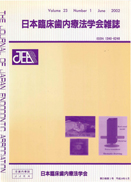Volume 19, Issue 2
Displaying 1-9 of 9 articles from this issue
- |<
- <
- 1
- >
- >|
Review Article
-
1998Volume 19Issue 2 Pages 131-138
Published: 1998
Released on J-STAGE: April 30, 2019
Download PDF (9821K)
Original Article
-
1998Volume 19Issue 2 Pages 139-142
Published: 1998
Released on J-STAGE: April 30, 2019
Download PDF (2574K) -
1998Volume 19Issue 2 Pages 143-149
Published: 1998
Released on J-STAGE: April 30, 2019
Download PDF (4030K) -
1998Volume 19Issue 2 Pages 150-158
Published: 1998
Released on J-STAGE: April 30, 2019
Download PDF (6346K)
Case Report
-
1998Volume 19Issue 2 Pages 183-186
Published: 1998
Released on J-STAGE: April 30, 2019
Download PDF (1644K) -
1998Volume 19Issue 2 Pages 187-191
Published: 1998
Released on J-STAGE: April 30, 2019
Download PDF (1985K) -
1998Volume 19Issue 2 Pages 192-196
Published: 1998
Released on J-STAGE: April 30, 2019
Download PDF (2216K)
Medical Essay
-
1998Volume 19Issue 2 Pages 197-201
Published: 1998
Released on J-STAGE: April 30, 2019
Download PDF (2360K) -
1998Volume 19Issue 2 Pages 202-206
Published: 1998
Released on J-STAGE: April 30, 2019
Download PDF (1909K)
- |<
- <
- 1
- >
- >|
